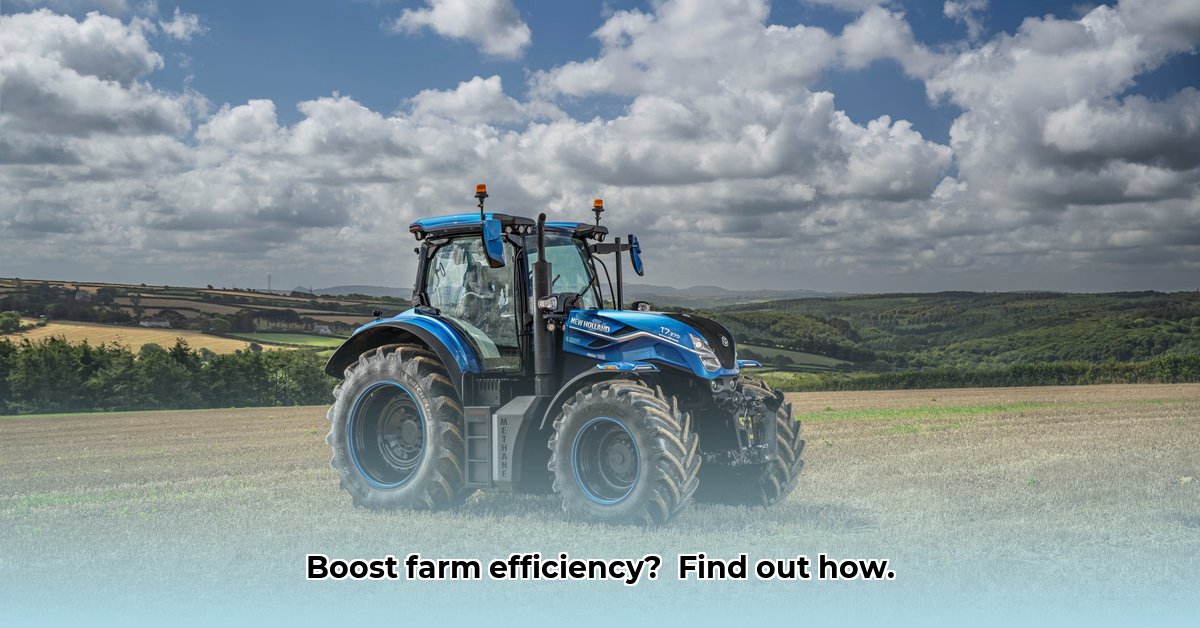
Farming faces increasing challenges, demanding higher efficiency and sustainability. New Holland addresses these needs with its innovative WORKMASTER and CR series, transforming how we approach agriculture. This article explores these machines' features, their contribution to sustainable practices, and actionable steps for various stakeholders to embrace this technological advancement. For more information on tractor dashboard symbols, see this helpful guide.
The WORKMASTER Series: Optimized for Small-Scale Sustainability
The WORKMASTER series caters to smaller farms, prioritizing fuel efficiency, maneuverability, and ease of operation. Equipped with advanced 3-cylinder diesel engines and smart fuel management systems, these tractors minimize fuel consumption, translating directly to cost savings and reduced greenhouse gas emissions. Their compact design and impressive maneuverability are crucial assets in navigating smaller fields and tight spaces, enhancing operational efficiency. User-friendly controls further reduce operator fatigue and potential for errors, increasing both productivity and safety. Many farmers praise the WORKMASTER's reliability and ease of maintenance, making it a valuable partner in their daily operations. But how significant are these fuel savings? Independent studies are needed to fully quantify these benefits.
CR Series Combines: Harvesting Efficiency Redefined
For larger-scale operations, New Holland's CR series combines offer unparalleled harvesting efficiency and reduced grain loss, leading to higher yields and improved profitability. These machines incorporate advanced automation technologies, minimizing labor costs and fuel consumption. The streamlined harvesting process reduces wasted time and resources, contributing to a more sustainable and cost-effective operation. The intuitive automation simplifies complex tasks, allowing operators to focus on larger-scale management instead of minute adjustments. While the benefits are evident, comprehensive research is needed to accurately quantify the long-term environmental impact of this automation throughout the entire lifecycle of the machines.
Sustainability: A Core Principle, Not Just a Trend
New Holland's commitment to sustainability isn't merely a marketing claim; it's deeply integrated into the design and functionality of its equipment. The fuel efficiency of both the WORKMASTER and CR series directly translates to lower greenhouse gas emissions. Automation minimizes fuel use and labor requirements, further reducing the environmental footprint. However, quantifying the overall sustainability impact requires further research. Independent studies are currently underway to evaluate the long-term environmental benefits comprehensively, considering various factors across the machine's life cycle. The goal: creating a transparent and complete picture of their environmental performance.
Actionable Insights: A Roadmap for Success
The benefits of New Holland's advanced agricultural machinery extend across the entire agricultural ecosystem. Here's a structured approach for various stakeholders:
1. Small-Scale Farmers:
- Short-term: Thoroughly evaluate the WORKMASTER series based on your specific needs. Request demonstrations and gather feedback from other users.
- Long-term: Investigate available financing options and government subsidies, planning for future upgrades and expansion based on your farm’s growth.
2. Large-Scale Farmers:
- Short-term: Conduct detailed cost-benefit analyses, considering the return on investment for the CR series combines. Focus on how increased efficiency directly impacts profitability.
- Long-term: Integrate advanced precision agriculture technologies to complement the new equipment, optimizing operations and yields.
3. Dealers and Distributors:
- Short-term: Highlight the significant fuel savings and reduced operational costs associated with New Holland tractors when marketing to potential customers.
- Long-term: Foster collaborations with technology companies to offer integrated farming solutions, creating seamless and comprehensive systems for improved efficiency.
4. Government Agencies:
- Short-term: Establish standardized metrics to accurately evaluate the environmental performance of agricultural machinery.
- Long-term: Implement policies and incentives that promote the adoption of sustainable farming technologies.
5. Research Institutions:
- Short-term: Conduct independent environmental evaluations of New Holland equipment to verify and expand on existing claims.
- Long-term: Focus research and development efforts on enhancing the sustainability of agricultural equipment.
Navigating Risks and Regulatory Compliance
Adopting new technologies always involves potential risks. Here's a summary of potential challenges and mitigation strategies:
| Technology | Short-Term Risks | Long-Term Risks | Mitigation Strategies |
|---|---|---|---|
| WORKMASTER Tractors | Fuel type limitations | Technological obsolescence | Explore alternative fuels; plan for timely upgrades |
| CR Combines | High initial investment | Software dependency | Secure financing; invest in comprehensive training |
| Automation Systems | Software malfunctions | Internet connectivity reliance | Implement robust cybersecurity; consider offline modes |
Staying informed about and complying with emissions and safety regulations is crucial for long-term success. Continuous adaptation to industry standards is essential.
Measuring Environmental Impact: A Path Forward
While the design features of New Holland's equipment clearly aim for sustainability, accurately measuring its environmental impact is a complex undertaking. A multifaceted approach is needed, involving standardized metrics for evaluating fuel efficiency, operational emissions, and the environmental costs of manufacturing and disposal. This requires collaboration between New Holland, independent researchers, and government agencies to establish clear, comparable data across the industry. The future of sustainable farming depends on this transparency.